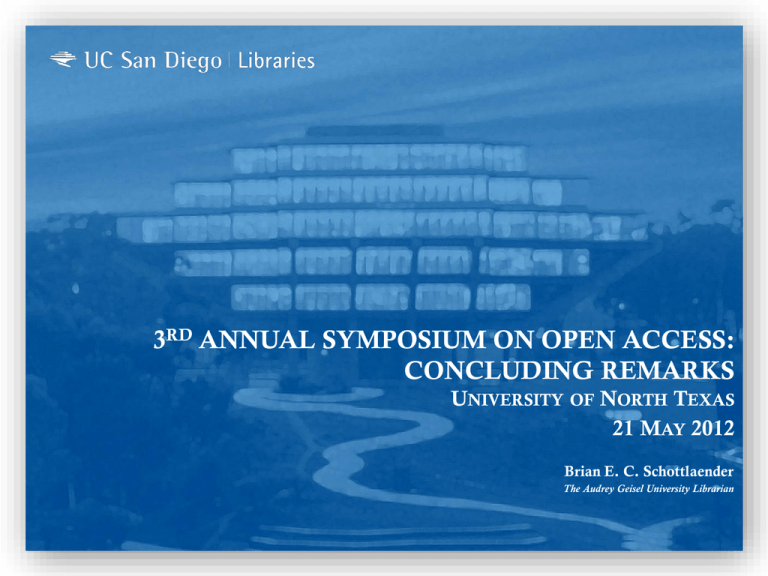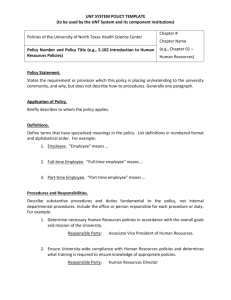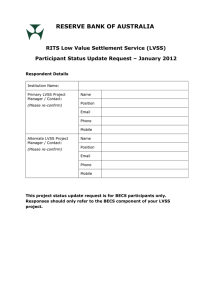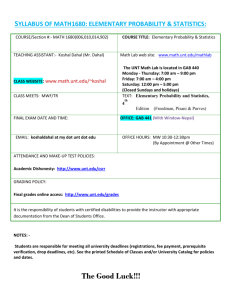3rd Annual Symposium on Open Access: Concluding Remarks
advertisement

3RD ANNUAL SYMPOSIUM ON OPEN ACCESS: CONCLUDING REMARKS UNIVERSITY OF NORTH TEXAS 21 MAY 2012 Brian E. C. Schottlaender The Audrey Geisel University Librarian WHAT I HEARD :: BECS :: UNT 2 DATA PRESERVATION :: BECS :: UNT 3 • The key reason for preservation is re-use => in fact, preservation IS re-use. [Choudhury] • "Without a deep, rigorous exploration and investigation of preservation, we run the risk of incomplete data management.“ [Choudhury] :: BECS :: UNT 4 DATA RE-USE :: BECS :: UNT 5 • Science is being transformed from something you observe in real time into something you accumulate over time and analyze later [Gutman] • Data archives are central to astronomy today => no longer "second-class science" [Hanisch] • Facilitating research with data isn't just about more data => it's about effective use of data [Droegemeier] :: BECS :: UNT 6 DATA AGGREGATION :: BECS :: UNT 7 • Data increasingly need to integrate with other kinds of data [Gutman] • Science is being transformed from something you observe in real time into something you accumulate over time and analyze later [Gutman] • The challenges associated with integrating heterogeneous data [and they are] are non-trivial. [Renear] :: BECS :: UNT 8 ATTRIBUTION CITATION PUBLICATION :: BECS :: UNT 9 • EZID => helps generate citations, with which you can get credit [Kunze] • Working to enrich data sharing and publishing infrastructure [Hanisch] • Need a system--and more importantly, a philosophy--for giving credit to faculty for generating, maintaining, and provisioning data [Droegemeier] :: BECS :: UNT 10 DATA ECOLOGY :: BECS :: UNT 11 • Preservation and reuse of data for scholarship is a mosaic of partnerships and roles [Gutman] • We need to both cooperate AND specialize [Gutman] • Objective: insert themselves into the scientist's workflow [Strasser] • NSB: Broad array of stakeholders [Griffiths] :: BECS :: UNT 12 W/ thanks to McKenzie Smith :: BECS :: UNT 13 Curation Ecology: technology view 1. Storage layer iRODS, S3, Palimpsest 2. Data management layer IRs, ICPSR, UK Data Archive 3. Linking (or Semantic) layer SFX, Semantic Web 4. Discovery layer Google/Google Scholar, ICPSR UI 5. Delivery layer content interaction tools, e.g. Ajax widgets like MIT Exhibit 6. Social layer myGrid/Taverna, Kepler, VREs, VIVO December 2010 6th International Digital Curation Conference ©MIT Curation Ecology: functional view 1. Storage layer Bit-level persistence 2. Data management layer Metadata, policies, preservation strategies 3. Linking (or Semantic) layer Identifiers, RDF, ORE encoding 4. Discovery layer Library catalogs, Web search engines, federated search 5. Delivery layer ebook readers, visualization tools, streaming media servers, security and ethics 6. Social layer collaboration tools, social networking tools, VLEs and VREs 7. Business layer cost recovery, legal/policy frameworks, virtual organizations December 2010 6th International Digital Curation Conference ©MIT Curation Ecology: organizational view 1. Research Groups (individual faculty, labs, Labs and Centers) knowledge producers/consumers (social layer) 2. Professional Societies knowledge aggregators (linking layer) 3. Data Centers system, data storage expertise (storage, data management layers) 4. Libraries and archives content/data management, data linking expertise (data management layer) 5. Businesses (Publishers, IT companies) discovery, delivery layers 6. Universities, Funders business, policy layers December 2010 6th International Digital Curation Conference ©MIT • Curation Ecology: data view – eScience – Data-driven research (experimental data) – Data-intensive research (hybrid data) [Griffin] :: BECS :: UNT 17 EXPECTATION-SETTING/ STOCK-TAKING :: BECS :: UNT 18 • ... a deep, rigorous exploration and investigation of preservation [Choudhury] • The challenges associated with integrating heterogeneous data [and they are] are nontrivial. [Choudhury] • … we need to know a lot more than we do now about all aspects of data creation and management. [Renear] :: BECS :: UNT 19 WHAT I DIDN’T HEAR MUCH ABOUT :: BECS :: UNT 20 PEER REVIEW :: BECS :: UNT 21 • How is quality assured and who determines it? [Droegemeier] • “Tread softly on the question of data quality.” [Hanisch] :: BECS :: UNT 22 DISCOVERY and DELIVERY :: BECS :: UNT 23 Ø :: BECS :: UNT 24 DATA GOVERNANCE :: BECS :: UNT 25 • Global Research Council just organized => G20 + OECD [Droegemeier] • Key questions … – Who owns it and when, and who decides? [Droegemeier] [There’s trouble in Whoville …] :: BECS :: UNT 26 EXHORTATIONS TO LIBRARIANS :: BECS :: UNT 27 • "When you don't have subscriptions, what've you got? What do you do?” [Gutman] • Librarians/Archivists/Curators: "How do I organize and manage data to help students and faculty answer their research questions, and do so going into the future?“ [Gutman] • Priority for support by libraries, by data type (low to high): – eScience simulation data – Experimental data 1 (automated collection/preparation) – Experimental data 2 (human involvement) – Higher-order computed data objects [Griffin] • Libraries can lead the effort to create new models for scholarly communication [Griffin] :: BECS :: UNT 28 • It's your [i.e., librarians'] responsibility to get the word out about the tools available to scientists. [Hulsey] • Librarians need to become comfortable with data [Griffiths] • ... a deep, rigorous exploration and investigation of preservation [Choudhury] • … we need to know a lot more than we do now about all aspects of data creation and management. [Renear] :: BECS :: UNT 29 “THE SCHOLARLY RECORD” Scholarly Publishing (e.g., journal articles) Libraries Trusted Third Parties (e.g., JSTOR, Portico) Stable :::BECS::: Ohio State University 2011.04.14 30 “THE SCHOLARLY RECORD” “Scholarly” = Scholarly & Scientific Infrastructures largely self-contained Scholarly Raw Material (e.g., archives, data) Scholarly Publishing (e.g., journal articles) Archives Data Centers [Some in Libraries; Some Not] Libraries Trusted Third Parties (e.g., JSTOR, Portico) Less Stable :::BECS::: Stable Ohio State University 2011.04.14 31 “THE SCHOLARLY RECORD” “Scholarly” = Scholarly & Scientific Infrastructures largely self-contained Scholarly Raw Material (e.g., archives, data) INPUTS Archives Data Centers [Some in Libraries; Some Not] Less Stable :::BECS::: Scholarly Inquiry/Discourse (e.g., blogs, wikis, open notebooks OPERATORS ????? Very unstable Emergent Ohio State University 2011.04.14 Scholarly Publishing (e.g., journal articles) OUTPUTS Libraries Trusted Third Parties (e.g., JSTOR, Portico) Stable 32 THANK YOU BECS@UCSD.EDU @UCSDBECS




